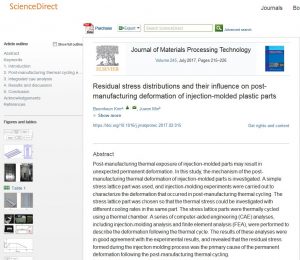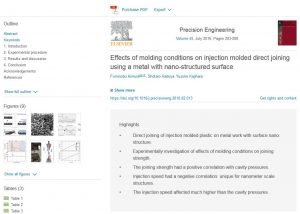“Analyze millions of scientific publication to discover the best match for your organization profile, your search criteria and the publication content”
Alexiaa��s platform is geared towards assisting you to uncover and optimize the value of the scientific publications you will find, to be as closely as possible related to the requirements of your organization, profile and criteria. Through our platform, research centers and universities provide access to thesis, doctorates, research works and more.
This valuable tool will span through thousands of scientific domains and technologies, giving you the latest researches in your area and the new technologies that you need to look for or attain.
Examples of this feature are shown below.
Residual stress distributions and their influence on post-manufacturing deformation of injection-molded plastic parts
Abstract Post-manufacturing thermal exposure of injection-molded parts may result in unexpected permanent deformation. In this study, the mechanism of the post-manufacturing thermal deformation of injection-molded parts is investigated. A simple stress lattice part was used, and injection-molding experiments were carried out to characterize the deformation that occurred in post-manufacturing thermal cycling. The stress lattice part was chosen so that the thermal stress could be investigated with different cooling rates in the same part. The stress lattice parts were thermally cycled using a thermal chamber. A series of computer-aided engineering (CAE) analyses, including injection-molding analysis and finite element analysis (FEA), were performed to describe the deformation following the thermal cycle. The results of these analyses were in good agreement with the experimental results, and revealed that the residual stress formed during the injection molding process was the primary cause of the permanent deformation following the post-manufacturing thermal cycling. Keywords Injection molding; FEM analysis; Post-manufacturing processes; Thermal cycling; Stress lattice; Injection molding; Residual stress A� 2017 Elsevier B.V. All rights reserved. Read more
Effects of molding conditions on injection molded direct joining using a metal with nano-structured surface
Highlights a�? Direct joining of injection molded plastic on metal work with surface nano-structure. a�? Experimentally investigation of effects of molding conditions on joining strength. a�? The joining strength had a positive correlation with cavity pressures. a�? Injection speed had a negative correlation: unique for nanometer scale structures. a�? The injection speed affected much higher than the cavity pressures. Abstract Injection molded direct joining (IMDJ) is one of the metal-plastic direct joining processes and is based on a combination of a special surface treatment of a metal piece and an insert molding. This study employed a chemical processing as the special surface treatment to form nano-structures on the metal piece. We investigated relationship between joining strengths and molding conditions; we focused on pressure of a mold cavity and injection speed as molding conditions in this work. To evaluate the IMDJ samples processed under various molding conditions, we carried out tensile-shear tests. Then we compared the results of the tests to discuss how much each condition variation affected the joining strength. From the discussion, we found an interesting effect of the injection speed, which is unique to the IMDJ using a metal piece with nano-structures. The findings of this study will promote a better understanding of the IMDJ. Keywords Metal-plastic direct joining; Injection molding; Nano-structures; Tensile shear strength A� 2016 Elsevier Inc. All rights reserved. Read more


